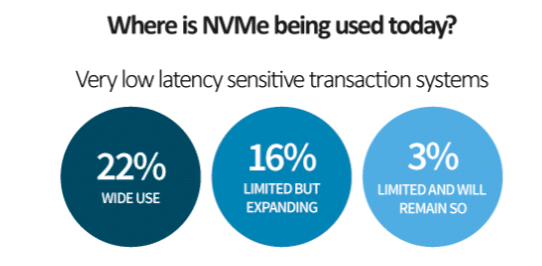Guest blog by Tony Lock, Director of Engagement & Distinguished Analyst, and Bryan Betts, Principal Analyst, of Freeform Dynamics Ltd
IT has always been hit by marketing waves that speak of new systems that will revolutionize the way everything works. Well, in IT as in real life, revolutions are few and far between — and it’s the steady creep of technology that brings most developments into widespread use. But some technology advancements impact parts of the IT infrastructure that are so important that any new development there needs careful consideration. Hence the question, are you ready for NVMe?
Are you ready for NVMe?
NVMe, the new standard for communications between servers and storage, offers many potential benefits over the existing widely used SAS and SATA. And performance is chief amongst them. But as with any new tech, when it first hits the streets or, more accurately, data centers, it arrives with a price premium. The questions usually then become: has the technology reached a level of maturity that justifies bringing it into use, and assuming it has, where does it make sense to use it first?
The crucial thing here is to have an accurate picture of the workloads being run and their importance to the business. Without this — and of course, without an understanding of how their performance could differ using NVMe — it can be very difficult, if not impossible, to justify any investment.
So where have the common starting points been for the use of NVMe so far? A recent study carried out by Freeform Dynamics showed that NVMe is most widely deployed supporting very low latency-sensitive transaction systems. Business-critical real-time analytics, data-intensive modelling and engineering were the workloads where NVMe was next most widely deployed, with demanding analytics workloads not far behind.

These kinds of workloads are a perfect fit for NVMe because they require fast access to data, and often to very large volumes of data. We also saw some take-up in large-scale virtual machine and desktop virtualization environments, and it’s likely that usage will expand fairly quickly here as the price differential between NVMe and traditional flash platforms diminishes.
Storage Investment Woes

For some of the current challenges in storage, making the business case for a budget request can be relatively straight forward, most notably when it comes to acquiring additional capacity. After all, if the storage systems are close to their limits, but users, customers and applications keep creating more data, there are only two choices: migrate data off of the storage platforms, or acquire more capacity.
While the capabilities built into storage systems to help with data migration and archiving have improved greatly in recent years, asking to move data off active systems can generate significant user and business resistance. It is often simpler just to buy more storage, at least assuming you have the space and power to install the extra hardware.
This can provide a convenient way to introduce NVMe systems into your computer rooms or data centers, but it will likely be a slow way to get NVMe widely deployed. Another big opportunity to bring NVMe into play will be if you have to bring in new infrastructure to support a new application or if an application is undergoing a major update. But again, NVMe adoption will be limited to how fast your organization is undertaking such projects.
The main opportunity to get NVMe deployed widely and quickly will be if you have kit that is either reaching its financial write-off, or if there is funding to replace out-of-support platforms. All of these approaches are well understood.
The Cost of Doing Nothing
But NVMe can provide another route through which to make the business case, and this involves recognizing that there are usually costs associated with taking the “do nothing” approach. NVMe can offer better performance and much lower latency for certain workloads, and improving service quality here can have visible business benefits.

For example, NVMe could bring the organization measurable financial benefits. For example, if it enables the IT infrastructure to be more responsive to applications and users, this in turn can improve customer experience thereby increasing order conversion rates. Alternatively, faster IT may allow more orders to be processed or facilitate faster analysis of business trends, enabling near-real-time actions to be taken as the business environment changes.
Some of these may not be areas that IT professionals will have explored in the past when making a business case for investment in storage, and they may be complex to quantify upfront. But as businesses look to become more agile and customer-centric, your storage platforms must be able to meet these new needs in terms of speed and responsiveness.
And one factor that is certain to make the business case easier to write is the fact that the price premium that NVMe products have over traditional SAS/SATA platforms continues to decrease. It may eventually even disappear.
Your IT Ecosystem
In the medium term and longer, NVMe usage could well expand to cover nearly all use-cases where users are actively engaged with data, especially if, as is distinctly possible, NVMe becomes standard in storage platforms across the board.
But, and this is an important caveat, the potential of NVMe storage can only be fully exploited if the rest of the IT infrastructure supports it. In particular, servers and networks must be able to take advantage of NVMe-enabled data capabilities such as very low latency and high data parallelization. For once, a lack of skills is unlikely to hinder adoption, as for many use cases there is little need for specialist NVMe knowledge.
The key to adoption, as ever, is to understand where to start. NVMe is now ready for the enterprise. The bigger question is, are you ready for NVMe? And, just as importantly, are your suppliers ready to help you make use of NVMe?
Are you ready for NVMe? Are your suppliers ready to help you make use of NVMe?
NVMe is End-to-End
Although much is made of NVMe’s role as the modern successor to SAS and SATA, in truth it is a lot more than that. Yes, it is a faster drive interface, with layers of software latency stripped out and no concessions made for legacy rotating media.
But that’s like the early days of SSDs, where flash storage was simply used to emulate a hard disk. You can get a useful speed boost that way, but nothing like as much of a boost as you can get if you use flash as flash, without asking it to pretend to be something else!
So just as flash really started to shine once it was built into devices such as All-Flash Arrays, with the disk metaphor largely discarded, the real value of NVMe will come through as we stop focusing on local storage and take it end-to-end.
It’s still very useful as a local storage interface, of course, and NVMe storage for a server (or a PC) is relatively cheap, with a shrinking price-premium over the cost of a PCIe SSD of the same size. Increasingly, NVMe is becoming the norm for local SSD in many use cases. However, the reality is that in almost every aspect, an NVMe SSD is still just a faster local hard drive.
See the Bigger Picture

NVMe can be so much more than that, though. Shared low-latency storage that bridges the performance gap between memory and disk drives enables whole new ways of thinking when it comes to designing and building applications and services. That means we need to think about the whole solution, not just what’s inside the server. Plus what’s inside a server is usually only accessible to that server (although there are proprietary schemes to virtualize, share and pool direct-attached NVMe).
In addition, there is the question of the weakest link in the chain: where is it? Except in a few cases – applications that are especially sensitive to latency, for example – it is unlikely to be the dir ect-attached storage in the servers. Speeding that up might give some nice benefits in terms of boot speed and server performance, but in the main, we are not talking solid business benefits here. It’s far more likely that there will be a bottleneck somewhere else in the networking and storage infrastructure.
There are caveats, of course, not least that when we talk about end-to-end NVMe we are very likely to be talking about NVMe-over-Fabric (NVMe-oF™), and that imposes requirements of its own. In particular, it may need a new or upgraded network fabric – but once that’s in place it is available to all servers on the network, with no need to remove the lid and install new cards or storage devices.
If your current infrastructure isn’t adequate then it’s better to build anew wherever possible, rather than trying to expand and stretch what you already have in place.
And fundamentally, as our research repeatedly shows, if your current infrastructure isn’t adequate then it’s better to build anew wherever possible, rather than trying to expand and stretch what you already have in place. If you can’t refresh everything in one go, put in as much new as you can manage, then move apps over as it becomes necessary and possible. Re-use what you can, of course, but renew the infrastructure that it sits upon so you can also bring in new hardware, software and systems as necessary.
As ever, the key is to think ahead and, whenever possible, build for the future rather than rebuilding the past. And end-to-end NVMe should be part of that future, the only question is when.
Learn More
Storage and Data Center Evolution – Freeform Dynamics

